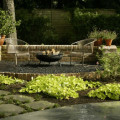Perennial Garden Design
Perennial garden design is a form of professionally developed garden that uses only perennial plants. These gardens can be large or small, formal or informal, depending on their relationship to home and surrounding yard. A variety of structures and hardscapes are also integrated into the plant life to make it more than a simple flower bed or outcropping of ornamental shrubs.
Remember, the key operative word here is “design.”
Key Processes
Process is fundamental to perennial garden design. There is an order to planning and developing a garden that professional Houston landscapers prefer to follow.
The first step is to determine how many gardens will be included in a particular Houston landscaping plan. In a typical project, multiple gardens are the norm, not the exception. Be mindful, however, that hardscape surfaces typically occupy far more square footage than do softscapes.
In order for gardens to create the sense of ordered beauty they are intended to create, they have to be planned in relationship to other structures. When gardens are viewed as compliments to the home and surrounding hardscapes, ideal locations for their placement are much easier to pinpoint and quantify during the consultation and planning phases of the project.
The next step is to determine the scale and scope of each perennial garden design. Each individual softscape operates on two different levels of scale and scope simultaneously.
- On one level, vertical impact and overall geometry must be proportioned to the home in a way that magnifies the importance of the residence.
- On another level, individual plants and trees within the garden establish scale and scope for other landscape elements located nearby.
It is not uncommon for trees in these gardens to act as focal points not only for the garden, but also for an entire zone of interest within the yard. Likewise, decorative gravel borders along the edges of the plants can bleed into the peripheries of walkways, patios, and masonry and lend an added sense of dimension to these forms.
Third, plant selection is made according once the preliminary phases of perennial garden design have been completed. When scale and scope are properly defined, and the location of each garden is clearly established, the right plants to use for each project often become readily evident.
Key Elements
Perennial garden design uses the same elements found in other styles of gardening. The only exception is that plants used in these areas are only those with life cycles lasting 2 years or more. Otherwise, virtually any species of vine, shrub, tree, bloom, or evergreen can be considered as a candidate for design.
Like all gardens, geometry and repetition are foundational to the success of the aesthetic. Plants need boundaries within which to grow. Plant species must also be varied to an extent, but they must also be repeated in patterns to indicate the guidance of a human plan in their development.
The difference between a professional perennial flower garden, for instance, and a do-it-yourself flower bed with perennial flowers is just that. One is a design; the other is a bed of wild growth that often overdoes too many colors and pays little or no attention to the impact that plant sizes and types have on surrounding structures.
With our perennial garden designs, order and system are always present in the form of balance, clearly defined borders, and integrated hardscapes such as gravel beds, garden patios, and walkways. Ornamental statuary, outdoor furniture, and also custom fountain design are key elements that are embedded within the structure of the garden itself.
Perennial garden designs are true designs, then, in every sense of the term, regardless of the particular plants, shrubs, or trees that they utilize. The aesthetic contributions that they make to the yard are intended to be long term in nature and dynamic in drama and interest.
Everything is deliberate, planned, and proportionally related to overall property curb appeal.

